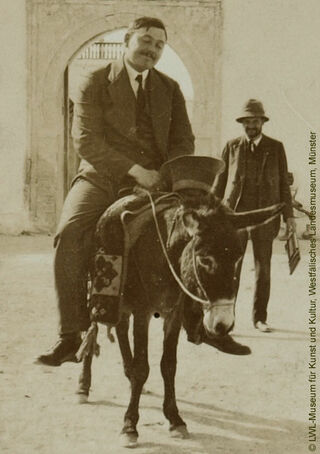Picture "Girl at the Fountain" (1913), black and silver-coloured framed version


Picture "Girl at the Fountain" (1913), black and silver-coloured framed version
Quick info
ars mundi Exclusive Edition | limited, 100 copies | numbered | certificate | reproduction, Giclée print on canvas | on stretcher frame | framed | size 96 x 52 cm (h/w)
Video
Detailed description
Picture "Girl at the Fountain" (1913), black and silver-coloured framed version
Like no other artist, August Macke was able to illuminate the colours on the canvas. The scenes he painted always portrayed the cheerful and light-hearted aspects of life. The "Girls at the Fountain" belongs to Macke's late work, in which the influence of Cubism was noticeable: the painting appears to be a composition of countless small surfaces and geometric shapes - almost like a church window.
Original: 1913, oil on canvas, 142 x 73.5 cm, Inv.No. 981 LM, LWL-Museum für Kunst und Kultur, Münster.
Edition transferred directly onto artist's canvas using the Fine Art Giclée process and stretched onto a stretcher frame. Limited edition of 100 copies, numbered, with certificate. Published in cooperation with the LWL-Museum für Kunst und Kultur, Münster. Photo: LWL-MKuK/Hanna Neander. Framed in a handmade, black-silver-coloured solid wood frame. Size 96 x 52 cm (h/w). ars mundi Exclusive Edition.
Frame configurator
Customised picture frame

Frame configurator
Customised picture frame







About August Macke
1887-1914
Radiant yellow, bright red, strong blue: the intensity and unique luminosity of the colours are typical of August Macke's work. In his paintings, Macke shows an intact world and primarily focuses on people. Probably because of the influence of his origins and the Rhenish cheerfulness, both as a person and as a painter, August Macke is considered to be one of the most famous German painters of the 20th-century.
Macke was a member of the artists' association "Blauer Reiter" and the most important representative of Rhenish Expressionism. He is considered the greatest German colour talent of his generation. But his drawings, sketches and designs also prove that he is one of the great artists of the 20th-century.
August Macke, born in Meschede on 3 January 1887, began his studies at the Kunstgewerbeschule and Kunstakademie Düsseldorf but dropped out prematurely. On journeys to France, Italy and the Netherlands he studied mainly Impressionism. With the artists of the "Blaue Reiter", whom he had known since 1911, he exhibited several times and contributed to the eponymous almanack. His financial security was assured by his sponsor Bernhard Koehler, an uncle of his wife Elisabeth.
Macke had already found his style of unmistakable independence. Inspired by Cézanne's tectonic pictorial structure and Matisse's flatness, he combined analytical Cubism with the pure colourfulness of Fauvism. The prismatic colours were the principal elements with which August Macke composed his painting. In doing so, the artist used the colours like a musician uses the tones, chords and scales of colourful forms.
As early as 1910, his friendship with Franz Marc enabled him to spend time at Lake Tegernsee. Macke's sensitivity for light effects was already evident in the paintings he created there. This is heightened in the watercolour paintings he produced on the famous trip to Tunis he made with Paul Klee and Louis Moillet in 1914. Simplification of form and the luminosity of the colours characterise this series of works.
For the first time in 1913, Macke‘s work was exhibited together with the works of the European avant-garde at the Sonderbund exhibition in Cologne, which he co-organised.
From 1913 Macke lived in Switzerland with his wife Elisabeth and his son Walter. But the family's happiness only lasted for a short time. As soon as the First Wolrd War began, August Macke was killed on the battlefield in Champagne, France, on 26 September 1914. His friend Franz Marc commented: "The greedy war is a hero's death richer, but German art poorer by one hero."
Graphic or sculpture edition that was initiated by ars mundi and is available only at ars mundi or at distribution partners licensed by ars mundi.
Artistic movement that replaced Impressionism in the early 20th century.
Expressionism is the German form of the art revolution in painting, graphic art and sculpture, which found its precursor in the works of Paul Cézanne, Vincent van Gogh and Paul Gauguin in the late 19th century. The Expressionists attempted to advance to the primal elements of painting. With vibrant, unbroken colours in large areas and with the emphasis on the line and the resulting targeted suggestive expressiveness, they fought against the artistic taste established by the bourgeoisie.
The most important representatives of Expressionism were the founders of "Die Brücke" (The Bridge): Ernst Ludwig Kirchner, Erich Heckel, Karl Schmidt-Rottluff, Max Pechstein, Otto Mueller and Franz Marc, August Macke and others.
Masters of Viennese Expressionism are Egon Schiele and Oskar Kokoschka. Among the sculptors, Ernst Barlach is the most famous.
Fauvism is the French form of Expressionism.
Depiction of typical scenes from daily life in painting, whereby a distinction can be made between peasant, bourgeois and courtly genres.
The genre reached its peak and immense popularity in Dutch paintings of the 17th century. In the 18th century, especially in France, the courtly-galant painting became prominent while in Germany the bourgeois character was emphasised.
Giclée = derived from the French verb gicler "to squirt, spurt".
The giclée method is a digital printing process. It is a high-resolution, large-format printout on an inkjet printer with special different-coloured dye- or pigment-based inks (usually six to twelve). The colours are fade-proof, i.e. resistant to harmful UV light. They have a high richness of nuance, contrast and saturation.
The giclée process is suitable for art canvases, handmade and watercolour paper as well as for silk.









